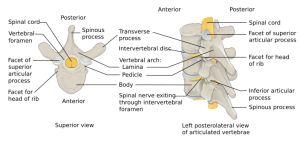Chance fracture: Difference between revisions
| Line 3: | Line 3: | ||
*Most common at T12-L2 due to spinal curvature and mechanism | *Most common at T12-L2 due to spinal curvature and mechanism | ||
*May be misdiagnosed as anterior compression fracture, which is usually stable | *May be misdiagnosed as anterior compression fracture, which is usually stable | ||
{{Vertebral fractures and dislocations types}} | |||
==Clinical Features== | ==Clinical Features== | ||
Revision as of 12:48, 24 October 2020
Background
- Unstable
- Most common at T12-L2 due to spinal curvature and mechanism
- May be misdiagnosed as anterior compression fracture, which is usually stable
Vertebral fractures and dislocations types
- Cervical fractures and dislocations
- Thoracic and lumbar fractures and dislocations
Clinical Features
- Common mechanism: seat belt serves as axis of rotation with failure of middle and posterior columns
- Seat Belt Injury: lap belt worn above the pelvic bones without a shoulder harness
- Mechanism: minor anterior vertebral compression with failure of the middle and posterior columns
- Intra-abdominal injuries more commonly associated than neuro deficits
Differential Diagnosis
Evaluation
Workup
- Obtain sagittally reconstructed CT if suspect lap-belt mechanism or flexion-distraction
Diagnosis
- Pure bony injury from posterior to anterior through:
- Spinous process
- Pedicles
- Vertebral body






